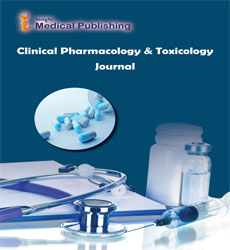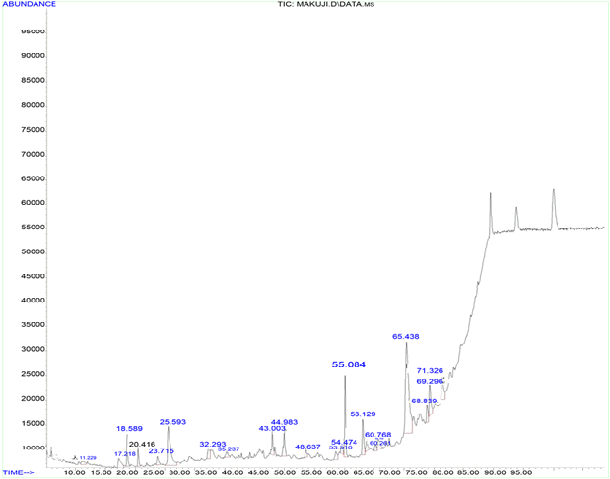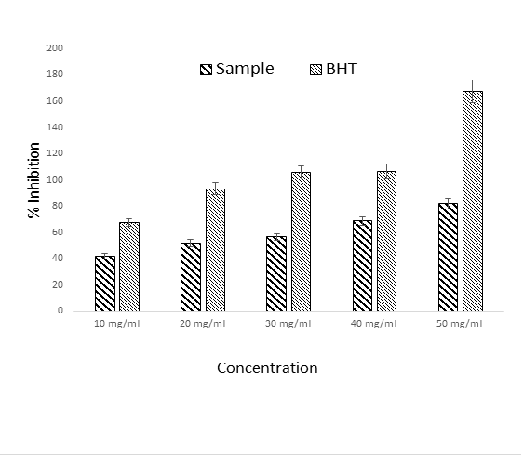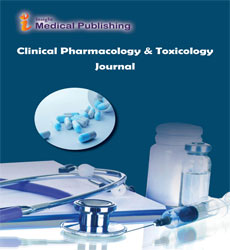Evaluation of Phytochemical Compounds and Invitro Antioxidant Properties of Ethanol Extract of Morinda Lucida Leaves
Idih FM1*, Alagbe OV2, Sheneni VD3, Ebune J1
1Kogi State University, P.M,B 1008, Anyigba, Kogi State, Nigeria.
2Federal College of Agriculture, P.M.B 623, Akure, Ondo State. Nigeria.
3Federal University Lokoja, P.M.B 1154, Kogi Sate, Nigeria.
*Corresponding author: Idih FM, Kogi State University, P.M,B 1008, Anyigba, Kogi State, Nigeria Tel: +2348143308906; E-mail: idihfavour@gmail.com
Received date: August 24, 2020; Accepted date: August 17, 2021; Published date: August 27, 2021
Citation: Idih FM (2021) Evaluation Of Phytochemical Compounds And Invitro Antioxidant Properties Of Ethanol Extract Of Morinda Lucida Leaves. Clin Pharmacol Toxicol Jour Vol.4 No.2.
Abstract
Plants are known to contain phytochemicals of pharmacological relevance and as such have been utilized in the treatment and management of various diseases, Morinda lucida is one of these plants as it has been reportedly used in the traditional treatment and management of diseases. This study is aimed at identifying compounds with pharmacological relevance in the ethanol extract of Morinda lucida leaves and its antioxidant activity. The leaves of Morinda lucida was extracted with ethanol; phytochemical analysis, GCMS and in vitro antioxidant activity were carried out. It was observed in the study that the extract contains alkaloids, quinines, quinones, flavonoids and tannins. The GCMS analysis identified phenol, 2, 4-bis (1,1-dimethylethyl) (2.82%), Stilbenes (12.32%), Phenoxazine (2.60%) and Benz(cd) indol-2(1H)-one, 1-methyl- (2.60%) amongst other compounds in the extract. The in vitro antioxidant activity evaluation of the extract revealed it possess a significant antioxidant activity which increased with increasing concentration. This study shows Morinda lucida possess enormous pharmacological potentials as it contains phytochemicals of pharmacological relevance.
Keywords: Morinda lucida, Bioactive Compounds, GCMS, Antioxidant, Phytochemicals
Introduction
The use of medicinal plants has been recorded throughout human history. Plants have the capability to synthesize wide range and varieties of phytochemicals that have the ability to exert important biological functions. Some of these phytochemicals have been widely researched and confirmed to possess medicinal properties. Medicinal plants continue to play important roles in health care, with about 80% of the world’s inhabitants relying mainly on traditional medicines for their primary health care [1].
Morinda lucida, a medium size tropical tree of about 15 meters tall having a scaly grey bark with short crooked branches and shining foliage according to Lawal et al. [2] is generally used as ingredients of fever teas, which are usually taken, for the traditional treatment of malaria. In West Africa Morinda lucida is an important plant in traditional medicine. In Africa, M. lucida is found mainly in West Africa and Central Africa. In the West Africa region M. lucida is spread across the coastal countries including Nigeria [3]. Morinda lucida is one of the four most used plants in the preparation of traditional medicines against fever in Nigeria. Decoctions and infusions or plasters of root, bark and leaves are recognized remedies against different types of fever, including yellow fever, malaria, trypanosomiasis and feverish condition during childbirth. The boiled leaves of M. lucida is used for the treatment of malaria in some part of Nigeria especially in the north central geopolitical zone where other parts of the plant such as the bark is also used for the treatment of meningitis. The leaves have also been reported to possess strong hypoglycemia, trypanocidal and aortic vasorelaxant activities [4].
This study is aimed at identifying the phytochemicals and bioactive compounds in the ethanol extract of Morinda lucida and to determine its in vitro antioxidant activity as well as the acute toxicity.
Materials and Methods
Sample Collection
The leaves of Morinda lucida were collected from Kogi State University Campus Anyigba, Kogi State, Nigeria and identified in the Botany Unit of the Department of Biological Sciences, Kogi State University, Anyigba, Kogi State, Nigeria with Batch Number 050.
Sample Preparation and Extraction
The leaves of Morinda lucida were air dried and pulverized using a Binatone BLG-450 blender. The pulverized sample was extracted with ethanol using the soxhlet extraction method. The sample extracted was weighed into a thimble and loaded into the chamber of the soxhlet extractor; 150ml of the solvent was poured into a different chamber attached to the soxhlet extractor, enough to siphon at least twice into the flask. The temperature of the experiment was set up to 750C and heated at reflux. This cycle was repeated over again for six hours. The extract was dried at room temperature and stored at 40C for further usage.
Qualitative Phytochemical Analysis
The qualitative phytochemical analysis was done following standard methods [5-6].
Gas Chromatography Mass Spectrophotometry (GC-MS)
GC-MS analysis of the extract was done using a Perkin–Elmer GC Clarus 500 system comprising an AOC-20i auto-sampler and a Gas Chromatograph interfaced to a Mass Spectrometer (GC-MS) equipped with an Elite-5MS (5% diphenyl/95% dimethyl poly siloxane) fused a capillary column (30 × 0.25 μm ID × 0.25 μm df). For GC-MS detection, an electron ionization system was operated in electron impact mode with an ionization energy of 70 eV. Helium gas (99.999%) was used as a carrier gas at a constant flow rate of 1 ml/min, and an injection volume of 2μl was employed (a split ratio of 25:1). The injector temperature was maintained at 250°C, the ion-source temperature was 200°C, the oven temperature was programmed from 60°C (isothermal for 2 min), with an increase of 30°C/min to 120°C, ending with a 3-min isothermal at 290°C. Mass spectra were taken at 70 eV; a scan interval of 0.5 s and fragments from 45 to 700 Da. The solvent delay was 0 to 2 min, and the total GC/MS running time was 21 min.
In Vitro Antioxidant Assay 1, 1-diphenyl 1-2-picrylhydrazyl (DPPH) Radical Scavenging Activity
One mL of various concentrations of the extracts in methanol was added to 4 mL of 0.1 mmol L–1 methanolic solution of DPPH. A blank probe was obtained by mixing 4 mL of 0.1 mmol L–1 methanolic solution of DPPH and 200 μL of deionized distilled water (ddH2O). After 30 min. of incubation in the dark at room temperature, the absorbance was read at 517 nm against the prepared blank. Inhibition of free radicals by DPPH in percent (I %) was calculated using this formula: %Inhibition = 100-((ABSsample – ABS blank)/ ABS control) x100.
Results
Phytochemical screening
Table 1 shows some of the phytochemicals detected in the ethanol extract of Morinda lucida leaves which are known to possess pharmacological properties.
| PHYTOCHEMICALS | Morinda lucida |
|---|---|
| Alkaloids | ++ |
| Quinines | ++ |
| Quinones | + |
| Anthraquinones | + |
| Tannins | + |
| Flavonoids | ++ |
| Saponins | + |
| Glycosides | + |
| Terpenoids | _ |
Table 1: Phytochemical Screening of Ethanol Extract of Morinda lucida Leaves (-) = not present.
(+) = present (++) = conspicuously present
Gas Chromatograpy Mass Spectroscopy Analysis
Table 2 and Figure 1 represents the result from the GCMS analysis of the ethanol extract of Morinda lucida. The result showed the extract contains some compounds of pharmacological relevance.
| Peak | R.T. min | First scan | Max scan | Last scan | PK TY | Peak height | Corr. area | Corr. % max. | % of total | Area% | Library/ID |
|---|---|---|---|---|---|---|---|---|---|---|---|
| 3 | 18.589 | 262 | 267 | 278 | rBV | 6516 | 65873 | 8.97% | 2.82% | 2.82 | Benzeneacetic acid, 4-(1,1-dimethylethyl)-, methyl ester |
| 2,4-bis(1,1-dimethylethyl) Phenol | |||||||||||
| Oxirane, [[4-(1,1-dimethylethyl)phenoxy] methyl]- | |||||||||||
| 6 | 25.593 | 394 | 405 | 433 | rBV | 7917 | 287546 | 39.13% | 12.32% | 12.32 | (E)-Stilbene |
| (E)-Stilbene | |||||||||||
| Phenanthrene, 9,10-dihydro- | |||||||||||
| 18 | 60.768 | 1094 | 1098 | 1112 | rVB3 | 1996 | 60577 | 8.24% | 2.60% | 2.6 | Phenoxazine |
| Benz(cd) indol-2(1H)-one, 1-methyl- | |||||||||||
| 2-Amino-1-acenaphthenone |
Table 2: Compounds Present in Ethanol Extract of Morinda lucida Leaves.
In Vitro Antioxidant Activity
Figure 2 shows the in vitro antioxidant properties using DPPH radical scavenging activity of the extract. The extract showed significant antioxidant activity which increased with increasing concentration of the extract.
Discussion
Plants are known to contain chemical compounds which are generally known as phytochemicals, some of this compounds possess pharmacological activities as well as other bioactive potentials. The use of plants for various purposes beneficial to humans especially in the treatment of ailments dates back to many centuries ago. Morinda lucida is one of these plants with numerous pharmacological benefits.
Researching into bioactive compounds in plants especially those known for their traditional use in the treatment of disease is important as there is rise in number of diseases around the globe and resistance of some diseases to existing treatment options.
In this study it was observed that the ethanol extract of M. lucida leaves contain phytochemicals of pharmacological relevance (Table 1), this include alkaloids, quinines, quinones, flavonoids and tannins. Further analysis using gas chromatography mass spectroscopy identified the compounds found in the extract (Figure 1 and Table 2), these include amongst others phenol, 2,4-bis(1,1-dimethylethyl) (2.82%) a compound which was reported in a study[7] to inhibit and disrupt biofilms as well as increasing the susceptibility of S. marcescens to gentamicin when administered synergistically, the study suggested this opens another avenue for combinatorial therapy where phenol, 2,4-bis(1,1-dimethylethyl) can be used to enhance the efficacy of conventional antibiotics; Stilbenes (12.32%) were also found in the extract, this compound according to Alberta et al [8] inhibits zones for bacteria and fungi in a way that was comparable with those of the antibiotics tetracycline, streptomycin, ampicillin, or kanamycin, directed against prokaryotes, and nourseothricin or hygromycin controlling fungi, respectively; Phenoxazine (2.60%) a compound reported [9] to enhance cellular penetration, nuclear accumulation, and subsequent antisense activity was found in the extract and Benz(cd) indol-2(1H)-one, 1-methyl- (2.60%) involved in treating, inhibiting or controlling a ras-associated disease by inhibiting farnesyl-protein transferase(FPTase) enzyme, treating ras oncogene dependent tumors according [10] was also present in the extract.
The in vitro antioxidant activity evaluation of the extract revealed it possess a significant antioxidant activity which increased with increasing concentration of the extract, this validates the use of this plant in the management of diseases related to oxidative stress.
Conclusion
This study revealed the ethanol extract of Morinda lucida leaves contain compounds of pharmacological relevance as well as those relevant in other biological activity, this compounds include benz(cd) indol-2(1H)-one, 1-methyl-, Phenoxazine, stilbenes and phenol, 2,4-bis(1,1-dimethylethyl) amongst others. The extract also possess significant antioxidant activity. This study suggest further research into possibility of harnessing the enormous pharmacological potential of Morinda lucida.
References
- Owolabi J, Omogbai EKI, Obasuyi (2007) Antifungal and antibacterial activities of the ethanolic and aqueous extract of Kigella africana (Bignoniaceae) stem bark. African Journal of Biotechnol 6: 882-885.
- Lawal HO, Etatuvie SO, Fawehinmi AB (2012) Ethnomedicinal and pharmacological properties of Morinda lucida. Journal of Natural Products 5: 93-99.
- Zimudi C, Cardon D (2005) Morinda Lucida Benth. In: Jansen, P.C.M. Cardon, D. (Eds). Plant Resources of Tropical Africa.
- Taofeeq O, Ibrahim B, Ganiyu A, Abdul-Waheed A, Gassal R, Godwin A (2010) Hepatotoxicity and nephrotoxicity evaluation in Wistar albino rats exposed to Morinda lucida leaf extract. North American Journal of Medical Science 2: 230-233.
- Sofowora A (2008) Medicinal plants of Traditional Medicine in Africa. 3rd Edition, Ibadan, Nigeria Spectrum Books 199.
- Trease GE, Evans WC (2002) Pharmacognosy. 15th Ed. London: Saunders Publishers 42â??44, 221â??393.
- Padmavathi RA, Abinaya B, Pandian SK (2014) Phenol, 2,4-bis(1,1-dimethylethyl) of marine bacterial origin inhibits quorum sensing mediated biofilm formation in the uropathogen Serratia marcescens. Biofouling 30: 1111-1122.
- Alberta S, Horbach R, Deising HB, Siewert B, Csuk R (2011) Bioorganic and Medicinal Chemistry 19: 5155-5166.
- Flanagan W, Wagner R, Grant D (1999) Cellular penetration and antisense activity by a phenoxazine-substituted heptanucleotide. Nat Biotechnol 17: 48â??52.
- Ayral-Kaloustian S, Kitchen DB, Schenectady, Shavnya A (2001) Method of inhibition of farnesyl-protein transferase using substituted benz (cd) indol-2-imine and-aminedervatives. United States Patent 9: 765-911.

Open Access Journals
- Aquaculture & Veterinary Science
- Chemistry & Chemical Sciences
- Clinical Sciences
- Engineering
- General Science
- Genetics & Molecular Biology
- Health Care & Nursing
- Immunology & Microbiology
- Materials Science
- Mathematics & Physics
- Medical Sciences
- Neurology & Psychiatry
- Oncology & Cancer Science
- Pharmaceutical Sciences


